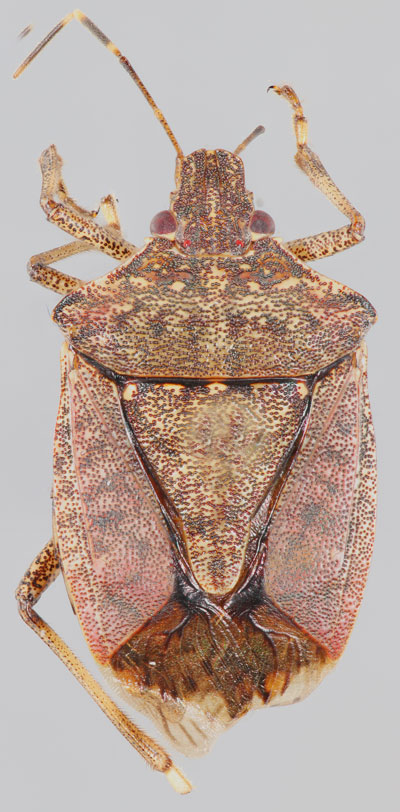Brown Marmorated Stink Bug in Montana
Hot off the press! See this printable PDF (738 KB) for our most recent publication on the first report of BMSB in Montana.
The brown marmorated stink bug (BMSB), Halyomorpha halys, has been confirmed in Billings (on January 26, 2021, from a household near downtown Billings-found alive inside the home). It has also been confirmed in Kalispell (2021) and Hamilton (2022).

Adult brown marmorated stink bug. Photo by Laurie Kerzicnik, MSU. Large image (850KB)
The brown marmorated stink bug was introduced from Asia and is now established in 46 states (Montana is the 47th state but not sure if it is yet established) and 4 Canadian provinces. It attacks over 170 different plant species. This is a pest that was expected to arrive in Montana. Its potential impact on crops, specialty crops, backyard gardens, and as a fall home invader in Montana are unknown.
Damage
Brown marmorated stink bugs have stylets, which pierce into the fruit, pods, buds, leaves, and stems of several plants.
Preferred Hosts
Yard and garden: Some preferred hosts in the yard and garden include catalpa, sunflower, crab apple, apple, cherry and other Prunus species.
Crops: Corn is a favored host of BMSB.
Specialty Crops: Specialty crops at high risk to BMSB damage include apples, pears (Asian and European), grapes, peaches, sweet corn, peppers, Swiss chard, and tomatoes.
What We Know About BMSB
- Wide host range
- Damaging pest of apples, grapes, cherries, and several other Prunus spp.
- Harmless to humans
- Invades homes in the fall (nuisance pest)
- It is a serious pest of economic importance for tree fruits in the mid-Atlantic states and has caused more than $37 million worth of damage (report as of 2010).
-
Its detection in other states poses problems ranging from a nuisance pest to a severe agricultural pest.
What We Don’t Yet Know About BMSB in Montana
- If it is established in Montana (if reproductive populations exist in Billings and other areas of the state)
- What hosts it might impact and whether it will be a pest of economic importance for crops and specialty crops
Monitoring and Management
- Several cooperating state and federal agencies have been monitoring for BMSB for several years in Montana.
- Monitoring efforts will continue with a focus in the Billings area.
- Please send suspected specimens and/or detailed photos to your local extension agent or samples can be submitted to the Schutter Diagnostic Lab and further directions can be found at the Schutter Diagnostic Lab website. Please note: there are several look-alike insects (see the Stop BMSB page).
- Detailed management information and other information about the pest can be found at the stopbmsb.org website.
Further Information
Many thanks to Bruce and Amy Morey for collecting the specimen (and initial diagnosis) and Amy Grandpre (Yellowstone County Extension, MSU) for sending the specimen to the Schutter Diagnostic Lab.
To learn more about the topics discussed on this page, contact the Schutter Diagnostic Lab. If you suspect an infestation on your property, contact your local extension agent, the Schutter Diagnostic Lab at Montana State University, or the Montana Department of Agriculture.
This May 2021 fact sheet is also available as a Printable PDF (650KB).
Disclaimer: These recommendations are provided only as a guide. It is always the pesticide applicator’s responsibility, by law, to read and follow all current label directions for the specific pesticide being used. If any information in these recommendations disagrees with the label, the recommendation must be disregarded. No endorsement is intended for products mentioned. The authors and Montana State University assume no liability resulting from the use of these recommendations. The Montana State University Extension Service is an ADA/EO/AA/Veteran’s Preference Employer and Provider of Educational Outreach.
